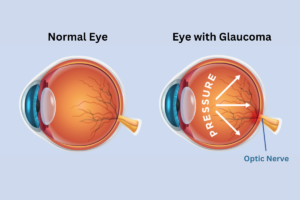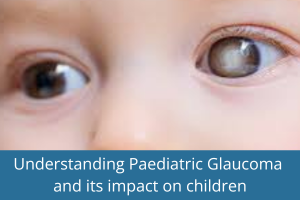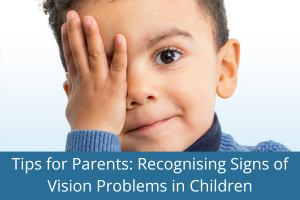Table of Contents
ToggleUnderstanding Paediatric Glaucoma and its impact on children

What is Paediatric Glaucoma?
Paediatric glaucoma is a rare but serious eye condition that affects children, leading to increased intraocular pressure within the eye. If not diagnosed and treated early, it can cause significant damage to the optic nerve and impact vision. In this blog post, we will explore the different types of paediatric glaucoma, symptoms, diagnosis, treatment, and its overall impact on children and their families.
Types of Paediatric Glaucoma
- Primary Congenital Glaucoma: This form of glaucoma is present at birth and is due to abnormal development of the eye’s drainage system. It leads to increased pressure inside the eye and can cause enlargement of the eye, excessive tearing, and sensitivity to light.
- Secondary Glaucoma: This type of glaucoma can result from other conditions, such as inflammation, trauma, or cataracts. It can occur later in childhood after birth.
- Juvenile Open-Angle Glaucoma: This is a rare form of glaucoma that can present in older children and adolescents. It is characterised by an open angle in the eye’s drainage system, and its cause is often genetic.
Symptoms of Paediatric Glaucoma
- Excessive tearing: Children with glaucoma may have a watery eye or excessive tearing.
- Photophobia: Light sensitivity can cause discomfort and irritability in children.
- Enlarged eyes: In some cases, children’s eyes may become enlarged.
- Cloudy cornea: A hazy appearance in the cornea can indicate increased intraocular pressure.
These symptoms can vary depending on the type and severity of glaucoma. Parents and caregivers should watch for these signs and seek professional eye care advice.
Causes of Paediatric Glaucoma
- Genetic factors: Genetic mutations can contribute to abnormal development of the eye’s drainage system, leading to congenital glaucoma.
- Abnormal eye development: Certain conditions during pregnancy can affect the development of the eye’s drainage system, resulting in congenital glaucoma.
- Inflammation and Infections: Inflammatory eye conditions and infections can sometimes cause secondary glaucoma in children.
- Trauma: Eye injuries and trauma can lead to secondary glaucoma later in life.

Impact of Paediatric Glaucoma on Children’s Vision and Development
Paediatric glaucoma can have a profound impact on a child’s vision and overall development:
- Vision loss: Untreated glaucoma can lead to optic nerve damage and gradual vision loss.
- Learning difficulties: Visual impairment can affect a child’s academic performance and ability to participate in activities.
- Psychosocial effects: Children with glaucoma may experience frustration and isolation due to vision challenges.
Diagnosis of Paediatric Glaucoma
Paediatric glaucoma requires early diagnosis to prevent potential vision loss. Ophthalmologists use several techniques to identify glaucoma, including:
- Examination of the eye
- Refraction
- Tonometry: Measuring intraocular pressure to determine whether it is elevated.
- Assessment of the optic nerve
- Imaging tests: Such as optical coherence tomography (OCT) to assess the optic nerve and structural changes.
Early detection is crucial in managing paediatric glaucoma, and regular eye exams can be vital in identifying any abnormalities.
Treatment and Management of Paediatric Glaucoma

1. Medication
- Topical medications: These are eye drops that are commonly prescribed to reduce intraocular pressure (IOP). They work by either decreasing the production of aqueous humour (the fluid inside the eye) or enhancing its outflow. Some examples include prostaglandin analogues, beta-blockers, and carbonic anhydrase inhibitors.
- Oral medications: In some cases, oral medications may be prescribed, such as carbonic anhydrase inhibitors, which help reduce fluid production within the eye. This is a short term treatment.
2. Surgery
- Trabeculotomy: This is a surgical procedure often performed on infants or very young children. It involves creating a new drainage pathway in the eye by making a small incision in the trabecular meshwork (the eye’s drainage channel) from the outside of the eye. This helps to lower intraocular pressure.
- Goniotomy: This procedure is typically done in children with primary congenital glaucoma. A goniotomy is where the eye surgeon makes an incision in the trabecular meshwork from the inside of the eye, to allow fluid to drain more efficiently and reduce intraocular pressure.
3. Drainage devices
- Implantable shunts or tubes: In cases where medications and surgery are not sufficient to manage intraocular pressure, drainage devices may be used. These devices create new drainage pathways and help fluid to exit the eye more effectively, reducing pressure. Examples include tubes like the Ahmed valve implant or the Paul tube implant.
4. Regular Monitoring and Follow-up
- Consistent follow-up with an ophthalmologist is crucial in managing paediatric glaucoma. Monitoring the child’s response to treatment, checking intraocular pressure, and assessing the optic nerve health are all part of the ongoing management strategy. Adjustments in medication or surgery may be necessary based on the child’s response to treatment.
Conclusion
Paediatric glaucoma is a complex eye condition that requires prompt diagnosis and effective treatment to prevent vision loss and associated complications. Understanding the symptoms, diagnosis, causes, and management strategies can empower parents and caregivers to provide the necessary care and support for affected children.
If you are seeking expert advice and care for paediatric glaucoma or other eye conditions, Clarity Eye Surgeons in Canberra offers comprehensive and compassionate ophthalmology services. Don’t hesitate to reach out to us for personalised consultation and treatment.
Author Bio
Dr Parth Shah is a director and principal ophthalmologist at Clarity Eye Surgeons in Canberra, with a special interest in paediatric ophthalmology. With extensive training and experience, he is renowned for his expertise in the field. Dr Shah is dedicated not only to performing successful surgeries but also to patient education. His compassionate approach, combined with technical proficiency, has earned him the trust and gratitude of countless patients. He is a true advocate for eye health and a trusted name in the Canberra ophthalmology community.
FAQs
Paediatric glaucoma can be diagnosed at any age, including infants and young children. Early diagnosis is crucial to effective treatment and management.
Regular eye exams are recommended for children, especially if there is a family history of glaucoma or other eye conditions. Consult with your ophthalmologist to determine the appropriate schedule based on your child’s needs.
Yes, paediatric glaucoma can affect one eye or both eyes. The symptoms and progression can vary depending on the type and severity of glaucoma.
Some non-surgical interventions, such as eye drops or oral medications, can be used to manage intraocular pressure. However, surgery remains a primary treatment option, especially for severe cases.
No, paediatric glaucoma is a rare condition. However, early intervention and treatment are crucial to prevent vision loss and manage the condition effectively.
Paediatric glaucoma and adult glaucoma can have different causes, symptoms, and treatment approaches. Paediatric glaucoma often presents with larger eyes and cloudier corneas, whereas adult glaucoma symptoms typically develop more gradually and can include peripheral vision loss.
If left untreated, paediatric glaucoma can lead to severe vision impairment or blindness. Early diagnosis and treatment are essential for managing the condition effectively.
Glaucoma can have a genetic component, and there can be a familial predisposition. However, it is not exclusively passed down from either the mother or the father. Genetic factors can play a role regardless of the parent’s gender.
Both males and females can develop glaucoma. However, certain types of glaucoma, such as primary congenital glaucoma, might be more prevalent in boys.
Other blogs related to Paediatric Ophthalmology

Understanding Paediatric Glaucoma and its impact on children
Understanding Paediatric Glaucoma and its impact on children What is Paediatric Glaucoma? Paediatric glaucoma is a rare but serious eye condition that affects children, leading

The Importance of Early Eye Examinations in Children
The Importance of Early Eye Examinations in Children Introduction Eye exams for children provide invaluable insight into their visual health, facilitating early detection and intervention

Tips for Parents: Recognising Signs of Vision Problems in Children
Tips for Parents: Recognising Signs of Vision Problems in Children As parents, we want the best for our children, including their health and well-being. One

Understanding Strabismus in Children: Causes, Treatment, and What Parents Need to Know
Understanding Strabismus in Children: Causes, Diagnosis & Treatment Dr Parth Shah is the principal ophthalmologist at Clarity Eye Surgeons in Canberra. He understands that when

Paediatric Ophthalmology: Identifying and Treating Eye Conditions in Children
Paediatric Ophthalmology: Identifying and Treating Eye Conditions in Children Introduction Parents want their children to grow up healthy and happy. One of the most important
